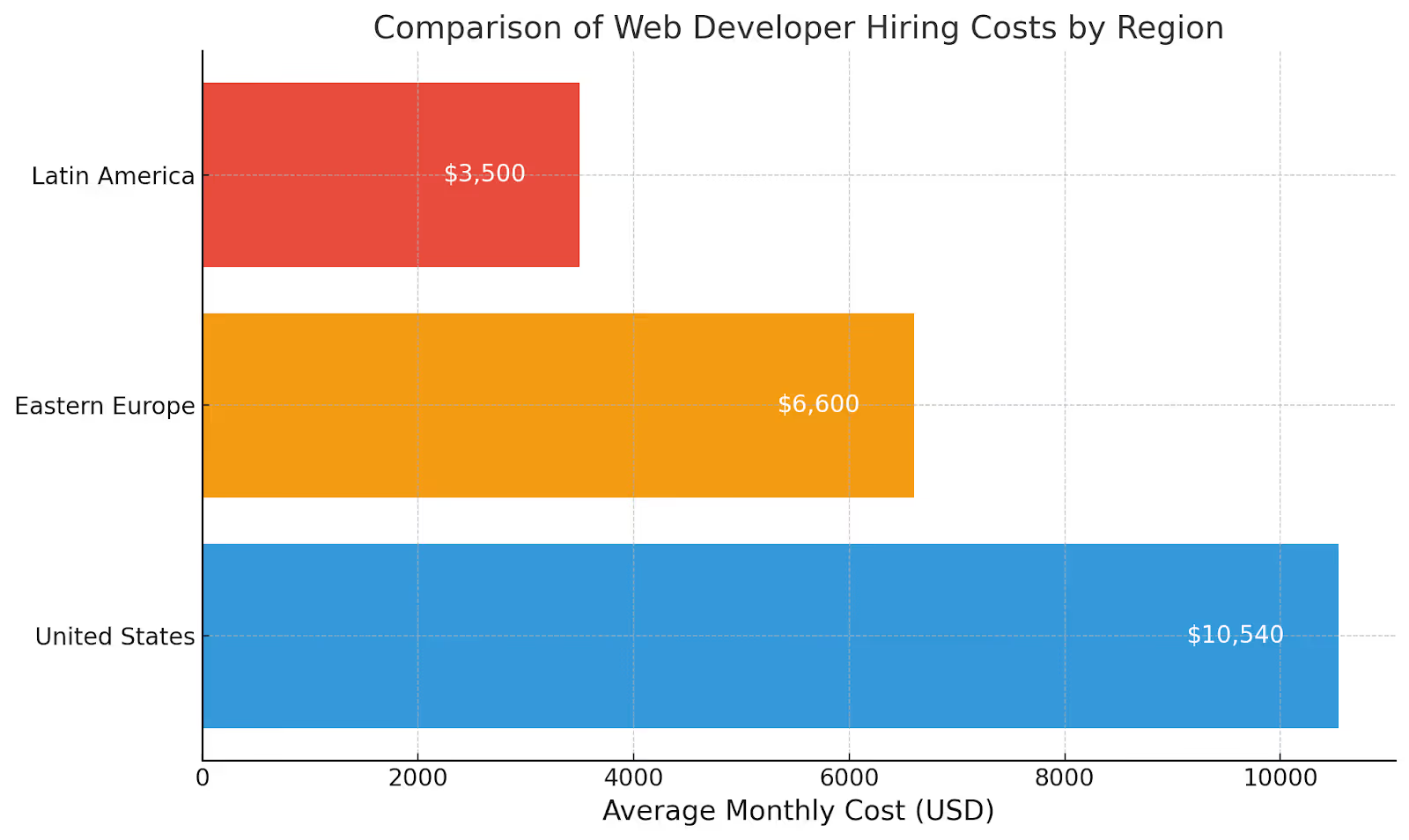Outsourcing web development is a key strategy for scaling quickly, accessing specialized talent, and avoiding lengthy internal hiring processes. It's no longer just a cost-cutting move—many U.S. companies now rely on it to stay agile, focus on core operations, and maintain high technical standards. Still, outsourcing isn't always the right answer, and not every region delivers the same value.
So when does it make sense to outsource, which model fits your business, and how much does it cost to outsource website development in today’s market? In this article, we break down the most effective outsourcing scenarios, the types of partners available, and the most cost-efficient regions—highlighting why Latin America stands out as a strategic option.
When Should You Outsource Website Development?
Outsourcing means partnering with external professionals to design, build, or maintain your website instead of relying solely on your in-house team. It’s a strategy that companies across the U.S. are using more and more to accelerate delivery timelines, access specialized skills, and maintain a lean operation without compromising quality.
But how do you know when outsourcing is the right choice?
Outsourcing is especially useful when:
- Your team is at capacity and you need to scale quickly without a lengthy hiring process.
- You lack specialized skills, such as advanced front-end frameworks (React or Vue) or CMS customization (Webflow or Shopify).
- You’re working on a one-off project that doesn’t justify expanding your internal team.
- You want to move faster. With the right partner, outsourced teams can start projects immediately and shorten development cycles.
The rise of outsourcing isn’t just anecdotal; it’s part of a much larger trend. Global revenue from IT outsourcing is expected to increase by over 50% between 2024 and 2029, surpassing $800 billion by the end of the decade. This steady growth reflects how essential outsourcing has become for companies that want to scale efficiently while being cost-conscious.
Types of Website Development Outsourcing
Website development outsourcing isn’t one-size-fits-all. There are several approaches, each with its own level of flexibility, scalability, and oversight. Choosing the right one depends on your technical needs, internal resources, and how involved you want to be in day-to-day execution.
Here are the primary models:
1. Freelance Developers: Typically hired for short-term tasks or specific components, freelance developers offer flexibility but require strong project management on your side.
2. Development Agencies: Agencies provide end-to-end solutions, including design, development, and QA. They operate as structured teams and are ideal for complex builds or when you need full-service delivery.
3. Offshore Teams: This model involves working with developers located in regions like Eastern Europe, Asia, or Latin America. Offshore teams can integrate into your workflows and are often used for long-term support or complete product builds.
4. Nearshore Teams: Similar to offshore, but geographically closer — often within your same time zone (e.g., Latin America for U.S. companies). Nearshoring improves real-time collaboration, reduces communication friction, and offers a cultural fit that's critical for agile development.
Each approach has its own pros and cons, and we’ll dive deeper into those — including the costs — in the next sections.
Learn more about why time zone overlap matters for LATAM outsourcing.
How Much Does It Cost to Outsource Website Development by Region
One of the biggest factors influencing the cost of outsourcing website development is the location of your development team. Depending on the region, monthly rates can vary significantly due to labor costs, time zone differences, communication styles, and retention challenges.
It ranges from $3,500 to $7,000 per month in Latin America, depending on experience and project complexity. U.S. developers cost over $10,000 per month.
Below is a breakdown of the average monthly pay for website developers by region.
United States
Average monthly cost: $10,540 ($65/hour)
Pros:
- Native English speakers
- Full cultural alignment
- Highly experienced professionals
Con:
- By far the most expensive option
Hiring developers in the U.S. offers the highest level of technical proficiency, seamless collaboration, and a deep understanding of local regulations and customer expectations. However, beyond the salary, companies often pay an additional 30–50% in benefits, taxes, and overhead, making it the least cost-efficient option for most startups or scale-ups.
Latin America
Average monthly cost: $3,500 (approximately $18–$25 per hour)
Pros:
- Time zone alignment with the U.S.
- Strong English skills
- Excellent value for money
Con:
- Slight variability in experience depending on country
Latin America has become a go-to region for U.S. companies outsourcing software development. The region offers top-tier talent at a fraction of the cost in the U.S., plus real-time collaboration thanks to overlapping time zones. Mexico, Colombia, and Brazil stand out for their growing tech ecosystems and cultural affinity with North America. This combination makes Latin America one of the most strategic and scalable outsourcing destinations today.
Eastern Europe
Average monthly cost: $6,600 (approximately $40–$55 per hour)
Pros:
- Strong technical skills
- Cultural proximity
Cons:
- Time differences can cause delays with U.S. teams.
Countries like Poland, Serbia, and Romania offer a great mix of affordability and quality. Developers in this region are known for their strong engineering backgrounds, high English proficiency, and experience working in distributed teams.

Web Development Outsourcing Costs in Latin America
For U.S.-based companies looking to optimize their hiring strategy, Latin America offers one of the best cost-to-talent ratios in the world. With high levels of technical expertise, cultural alignment, and real-time collaboration across time zones, it’s no surprise that the region is becoming a go-to hub for outsourcing web development.
In countries like Mexico, Brazil, Colombia, and Argentina, the average monthly cost to hire a mid-level web developer ranges from $3,125 to $4,365, while senior developers typically cost between $5,625 and $7,000 per month. This translates to hourly rates between $19 and $43, offering significant savings compared to U.S.-based talent — without sacrificing quality or responsiveness.
But how much does it really cost to hire in the region?
How to Outsource Website Development Without Overpaying
How much does it cost to outsource website development? It’s a smart, cost-effective decision—but only if approached strategically. To ensure you receive high-quality work at a fair price, it’s essential to understand the right steps before signing a contract.
Here’s a breakdown of how companies in the U.S. can start outsourcing successfully while keeping costs under control.
Step-by-Step Guide to Cost-Efficient Outsourcing
1. Define your project scope and goals.
Before hiring, make sure you know what you need. Are you building a landing page, a custom e-commerce platform, or a full software as a service (SaaS) product? The complexity will determine the type of talent and experience level you’ll need — and ultimately, how much you’ll pay.
2. Choose the best outsourcing region for your business.
The cost of hiring a web developer varies significantly depending on the region, but price shouldn't be the only factor guiding your decision. Consider additional elements like time zone compatibility, communication flow, retention rates, and cultural alignment — all of which can directly impact your team’s productivity and collaboration.
3. Choose between freelancers, agencies, and specialized recruitment firms.
Freelancers may be suitable for smaller projects, but managing timelines and quality can be challenging.
Agencies offer comprehensive services, but they can be expensive and impersonal.
Specialized recruitment firms help you find pre-vetted developers who fit your budget, tech stack, and culture. These firms often offer transparent pricing and faster onboarding.
4. Validate communication and soft skills.
Technical skills are just half of the equation. Evaluate candidates' English proficiency, responsiveness, and ability to follow instructions, especially if you plan to work asynchronously.
5. Understand the true cost beyond salary.
When budgeting, remember to account for more than just hourly or monthly rates.
Ask:
- Will they work full-time or part-time?
- Are tools, licenses, or infrastructure included?
- Are there recruitment fees, management fees, or hidden charges?
Learn more about outsourcing tech roles. How to Choose the Best Agency.
Why Outsource Through Teilur Talent?
When companies ask how much does it cost to outsource website development, they often focus on rates and technical skills. But hiring remote developers is about more than just finding people with the right hard skills — it's also about finding professionals who are genuinely invested in your company's mission and long-term success. At Teilur Talent, we prioritize motivation, retention, and cultural alignment over simply matching technical profiles.
Here’s how we do it:
- Pre-engagement alignment: Before introducing a candidate to your team, we make sure that they understand your company's values, your website or product, the role, and your long-term goals. Only candidates who feel aligned and excited about the opportunity are submitted.
- Built-in retention strategy: We take retention seriously. Many of the developers we place stay with clients for two years or more, and we intentionally filter out candidates who frequently switch jobs unless you're hiring for a short-term project.
- Transparent pricing: At Teilur Talent, we operate on a clear and simple pricing model: a flat 20% service fee added to the developer’s base salary. This means there are no inflated margins or hidden fees — you have full visibility into what you're paying and what the developer is earning.
We provide personalized support, offering learning resources, introducing developers to mentors, and supporting their mental well-being. This ensures every developer feels supported beyond their day-to-day tasks.
Learn more about how Teilur Talent is disrupting the recruiting industry with transparent pricing.
FAQ
What is outsourcing in web development?
Outsourcing in web development refers to the practice of hiring external professionals or teams to design, build, or maintain a website. Instead of relying solely on in-house developers, companies can work with freelancers, agencies, or specialized outsourcing partners to access expertise, reduce development time, and lower costs.
Why outsource website development to Latin America?
Developers in countries like Mexico, Colombia, and Brazil offer high-quality work, strong English communication skills, and an average monthly cost ranging from $3,125 to $7,000, making it an efficient and cost-effective solution for the U.S.-based companies.
How much does it cost to outsource website development?
In the United States, a mid-to-senior developer typically costs around $10,540 per month. In contrast, Latin American developers offer similar expertise for significantly lower rates, ranging from $3,125 to $7,000 per month. This makes outsourcing to Latin America a compelling option for companies looking to balance quality with budget efficiency.
How much does it cost to pay someone to develop a website?
The total cost to develop a website can vary widely. A basic website might cost between $1,000 and $5,000, while more complex or custom platforms can range from $10,000 to $50,000 or more. Costs are influenced by the size of the project, required functionality, design complexity, and the region where the developers are based.
Conclusion
How Much Does It Cost to Outsource Website Development is one of the first questions companies ask when considering external support for their digital projects. Outsourcing web development can significantly impact how efficiently you scale, adapt, and innovate. Whether you're working on a one-time website or building a complex platform with multiple features, there are flexible and affordable options available. The real key is understanding what kind of service fits your goals, evaluating providers beyond just pricing, and partnering with a team that aligns with your vision and business model.
If you're considering hiring in Latin America, use our cost calculator to see how much you can save without compromising quality. Ready to get started? Schedule a call with us to learn how we can help you find the ideal team for your web project.








